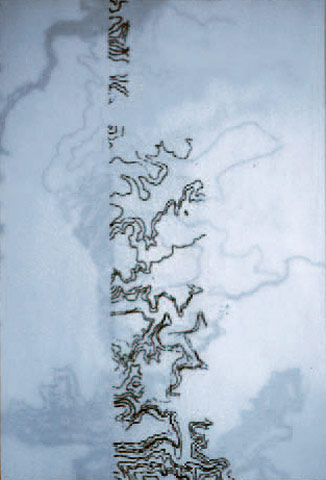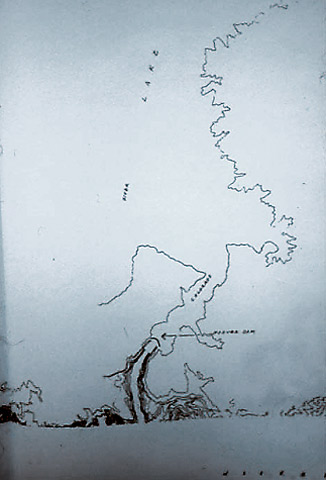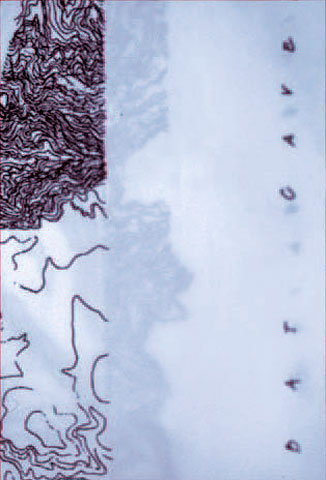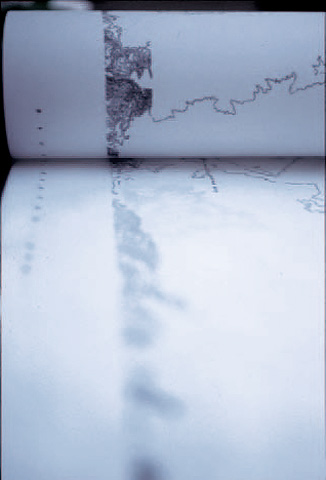
Permeo: Cardo:
A Plutonium Memorial
PERMEO CARDO was a collaborative proposal for a memorial for nuclear waste, which examines ways to represent landscape change over extreme time scales. Claire Dorlac-Leach (a graduate student in Landscape Architecture, now teaching and practicing in St. Paul, Minnesota) and I developed a design proposal for the Plutonium Memorial Competition in the winter of 2002. Sponsored by the Bulletin for Atomic Scientists, this competition asked artists and designers to develop ideas for the long-term disposal of plutonium and to design a corresponding memorial. PERMEO CARDO (traverse the line) uses scores and scripts to represent the guidelines and framework for memorializing a recovering landscape.

Motivated by the basic challenge of designing in the context of what exists but is not perceived, we developed a design investigation and corresponding proposal. This design project uses scores and scripts to represent the guidelines and framework for memorializing a recovering landscape. A site’s toxic legacy is remembered, not through structure and form, but through ritual and measurement, while the slow process of recovery takes place.
The design uses notation to anticipate discontinuity, leave room for the unpredictable, and allow for a remote author. The example is extreme, but offers a framework for scripting a design that must accommodate tremendous changes over a long period of time.

The Las Vegas Strip crosses on the 36th parallel, the latitude that traverses through the Hoover Dam and the Grand Canyon, reaching plutonium-239’s origin, the abandoned uranium mines on Navajo lands 434 kilometers east of Las Vegas. The Plutonium Memorial will be this line, a 434-kilometer trajectory on the 36th parallel linkingorigin to fate, transitioning with site and time.
This memorial recognizes the impermanence of singular monuments in the landscape. It will instead rely on a linear but discontinuous series of roads that traverse the present day 36th
parallel.

Human memory cannot rely on visual reminders alone. Memory survives through habit and ritual. If a memorial is to survive 48,000 years we must put it through a cultural legacy that is referenced to a fundamental physical phenomenon. The knowledge of the buried plutonium will persist through ritualized remembrance linked with the orbital movements of the earth and the moon.
A pilgrimage will take place between the storage facility and the abandoned mines along the 36th parallel on the eve of each solar eclipse. Through cosmological cues, the Plutonium Memorial will become a part of cultural memory.

The sublime penumbra, each time visible from a different point on Earth, will occur on average twice annually. Solar eclipses are inescapable and unforgettable. Linking them with a ritualized memory of plutonium - its origins and its burial - combines the disquieting effect of obscured sunlight with the legacy of plutonium.
A line in the landscape, determined solely by measurement of Earth is persistent on an otherwise shifting planet. Lines registering the physical geometry of the Earth will reliably mark time and link measurement between the present day and a quarter million years from now.

The physical memorial marks a covenant with the past. Any monument serves as a reminder of the past and a guide toward the future. This monument, with its vast lifetime must be intransitive in a transitive and malleable landscape. While the culture and landscape shifts around it, the line remains continuous and visible. The monument will read as a link to the past, holding cultural memory true to legacies of history.
The numbers stretch across the whole site (represented on 60 feet of mylar). The top row measures the distance in feet. The second row registers the years progressing from present to 24,000 years into the future. The third row records the timing and location of solar eclipses.
